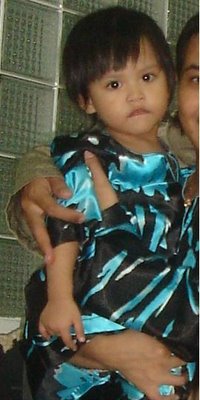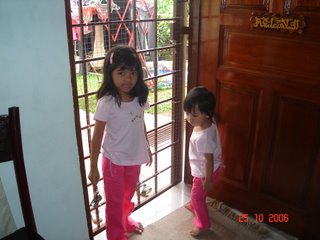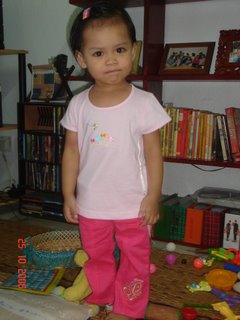17 November 2006
15 November 2006
abbb...brrruuuuuu...tattaaa...
itulah perkataan yg came our from Amani's mouth last night..instead of ibu...she called me abbbbruuu....lain diajar..lain yg kluar...aku ajar dia panggil ibu...abbbrruuuu gak yg kluar..tak pelah..Anis dulu2 pon panggil aku ABU....
Bersembur-sembur air liur Amani kluar bila dia abbb.brrruuuu..tuh, next word is tattaa...kadang2 tuh ade gak le dengar dia sebut kakak..tp sleng skit, so jadi tatak.., klu dia tengok gambar dia sendiri, dia akan tunjuk sambil sebut..aaatik... adik le tuh maknanya...next word is..tak ade, tapi amani nye version "ta de" or bila susu dah abis dia akan sebut tade...
List me list down Amani's word eh..
1) tattaa - bye-bye or tata
2) abbbrrruuuu - ibu
3) tatak - kakak
4) aatikk...adik
5) tade - tak ade or abis
6) aiiii - one
7) kour - four
8) aiii - five ( macam sama je bunyi one and five ni dik...camna tuh...layannn)
9) aiiiik - hai or bila dia tegur org
10) kuuu - thank you
11) alphabet ABC to Z..yg dia tau sebut A, B and O...tapi B tuh pon lain macam je bunyi dia..yg lain tuh...dia sengih je bila kita sebut..bertuah nye anak....
So, bila kira2..banyak jugak le words yg kluar dari mulut Amani..kira OK lah..slowly...pelan-pelah kayuh dik.....Sooo, klu sapa2 yg agak2 nak berborak ngan Amani nih, meh tuition ngan aku dulu..kang sorang cakap lain...sorang lagi cakap lain..
Bersembur-sembur air liur Amani kluar bila dia abbb.brrruuuu..tuh, next word is tattaa...kadang2 tuh ade gak le dengar dia sebut kakak..tp sleng skit, so jadi tatak.., klu dia tengok gambar dia sendiri, dia akan tunjuk sambil sebut..aaatik... adik le tuh maknanya...next word is..tak ade, tapi amani nye version "ta de" or bila susu dah abis dia akan sebut tade...
List me list down Amani's word eh..
1) tattaa - bye-bye or tata
2) abbbrrruuuu - ibu
3) tatak - kakak
4) aatikk...adik
5) tade - tak ade or abis
6) aiiii - one
7) kour - four
8) aiii - five ( macam sama je bunyi one and five ni dik...camna tuh...layannn)
9) aiiiik - hai or bila dia tegur org
10) kuuu - thank you
11) alphabet ABC to Z..yg dia tau sebut A, B and O...tapi B tuh pon lain macam je bunyi dia..yg lain tuh...dia sengih je bila kita sebut..bertuah nye anak....
So, bila kira2..banyak jugak le words yg kluar dari mulut Amani..kira OK lah..slowly...pelan-pelah kayuh dik.....Sooo, klu sapa2 yg agak2 nak berborak ngan Amani nih, meh tuition ngan aku dulu..kang sorang cakap lain...sorang lagi cakap lain..
06 November 2006
03 November 2006
Semalam 02/11/2006, aku bawa Amani ke HUKM sebab ade temujanji untuk Terapi cara kerja. Terapi cara kerja atau occupational therapy ini ialah suatu rawatan pemulihan yang diberikan kepada individu yang mengalami masalah fizikal, mental dan sosial dengan menggunakan aktiviti-aktiviti terapeutik sebagai media rawatan supaya individu tersebut dapat mencapai tahap kefungsiannya ke tahap yang paling optima dan dapat hidup berdikari.
Amani ni kan macam bermasalah sikit untuk pegang barang, pass barang (dulu2 lah) even botol susu dia pon sampai skrg dia tak nak pegang sendiri...tak nak pegang or tak tahu pegang...wallahhualam...
Tapi sekarang ni adelah sikit perubahan yg positif mcm ambil barang, pass brg, tendang bola, mengelak brg bila benda tuh halang laluan dia..klu dulu dia main redah je..panjat tangga turun tangga pun dah terer..panjat katil lagik terer...tp bab pegang botol nih yg aku hangin...camna nak wat tuh...
Ok, back to therapy, Therapist Amani namanya Fazillah or Kak Zie, disebabkan dah lama Amani tak pergi terapi nih..so Amani ni macam tak brp kenal le Kak Zie nih, dia stare je Kak Zie, diam je dia...baik pulak tuh..suruh duduk, dia duduk, suruh bangun dia bangun...pergghhh..baik le si Amani nih..comei je dia duduk kat kerusi n meja kecik tuh...
Kak Zie bagi satu alat mcm susun kon, Amani should amik and susun cone tuh kat sebelah...dah byk kali tunjukkan cara angkat and susun kon tuh, Amani buat dek je...klu kat umah tuh..klu kita tunjukkan cara 2..3 kali...dia akan ikut..tp smlm bab susun2 cone tuh..dia fail....
pastu Kak zie bagi game lain...cabut2 kiub..kiub2 tu melekat..macam pelekat zap on tuh..amani should cabut and letak kiub tuh dlm bekas..everytime dia cabut/tarik..dia bunyi.."uhh".."uhh"..macam berat sgt le benda tuh dia nak cabut...wahhh...dia berjaya lah.... Amani berjaya cabut kiub2 tulah.... tapi bila suruh susun balik ikut susunan..dia fail....fail lagik...
Next game is woodden puzzle...puzzle kayu yg ade gambar and bertombol...besar gedabak puzzle nih... Amani sepatutnye susun balik puzzle ni ikut acuan and gambar le...macam gambar kucing...shape puzzle tu pun, shape kucing ler...uwahhhh...puzzle ni pon dia fail gak....
So, next appointment is on 22/11/06...kena datang jugak...tok leh ponteng2 lagik therapy nih..bulan December nih..assesment nih...
Bila dah time bak balik tuh...dia dah ok skit le ngan Kak Zie, time balik tuh..beriya2 le pulak dok bye-bye orang tuh....siap patah balik tuh...nak bye-bye...
Amani ni kan macam bermasalah sikit untuk pegang barang, pass barang (dulu2 lah) even botol susu dia pon sampai skrg dia tak nak pegang sendiri...tak nak pegang or tak tahu pegang...wallahhualam...
Tapi sekarang ni adelah sikit perubahan yg positif mcm ambil barang, pass brg, tendang bola, mengelak brg bila benda tuh halang laluan dia..klu dulu dia main redah je..panjat tangga turun tangga pun dah terer..panjat katil lagik terer...tp bab pegang botol nih yg aku hangin...camna nak wat tuh...
Ok, back to therapy, Therapist Amani namanya Fazillah or Kak Zie, disebabkan dah lama Amani tak pergi terapi nih..so Amani ni macam tak brp kenal le Kak Zie nih, dia stare je Kak Zie, diam je dia...baik pulak tuh..suruh duduk, dia duduk, suruh bangun dia bangun...pergghhh..baik le si Amani nih..comei je dia duduk kat kerusi n meja kecik tuh...
Kak Zie bagi satu alat mcm susun kon, Amani should amik and susun cone tuh kat sebelah...dah byk kali tunjukkan cara angkat and susun kon tuh, Amani buat dek je...klu kat umah tuh..klu kita tunjukkan cara 2..3 kali...dia akan ikut..tp smlm bab susun2 cone tuh..dia fail....
pastu Kak zie bagi game lain...cabut2 kiub..kiub2 tu melekat..macam pelekat zap on tuh..amani should cabut and letak kiub tuh dlm bekas..everytime dia cabut/tarik..dia bunyi.."uhh".."uhh"..macam berat sgt le benda tuh dia nak cabut...wahhh...dia berjaya lah.... Amani berjaya cabut kiub2 tulah.... tapi bila suruh susun balik ikut susunan..dia fail....fail lagik...
Next game is woodden puzzle...puzzle kayu yg ade gambar and bertombol...besar gedabak puzzle nih... Amani sepatutnye susun balik puzzle ni ikut acuan and gambar le...macam gambar kucing...shape puzzle tu pun, shape kucing ler...uwahhhh...puzzle ni pon dia fail gak....
So, next appointment is on 22/11/06...kena datang jugak...tok leh ponteng2 lagik therapy nih..bulan December nih..assesment nih...
Bila dah time bak balik tuh...dia dah ok skit le ngan Kak Zie, time balik tuh..beriya2 le pulak dok bye-bye orang tuh....siap patah balik tuh...nak bye-bye...
02 November 2006
Language Development Skills..
Baby's First Communication Steps
Although most children develop language and communication skills naturally, "on their own", there are many strategies that adults can use with their children to enhance communication skills and development. There are many ways that adults often communicate with their children that is adequate for typical language development, however for some, getting an early start on communicating in a better way, may help to reduce a child (at risk) from developing a speech and language delay. I would like to provide periodic "talking tips" to parents and caregivers of children to help in the prevention of communication delays, but just as importantly to help foster improved communication skills between adults and children. Improved communication may help with your child's development of self esteem, increase the trusting relationship between the child and adult, and foster a happy, loving environment in which to grow and learn.
STEP 1: Observe your child's interests...
Several strategies can be used to enhance communication with your child. The first step is to notice what your child is interested in talking or learning about. Children will tell us if not verbally, through gesturing, eye gaze, body movements, or vocalizations what is interesting to them. We as parents, caregivers, or "communicators" must "listen" to our child not only with our ears, but with our eyes! When we know what makes our child happy, interested, inquisitive, we can use that to open up the doors of communication even wider. For example: If we are playing blocks with our child and their eye gaze moves from the blocks to the cat who just walked by, we can use this to change the communication/interaction to "talk" and learn about the cat. "oh, there is Kitty. Kitty likes to play", rather than continuing to play with the blocks. You may get a smile, vocalization "kit", or "kitty", or a pointing/reaching gesture. This little act of watching your child's focus of attention and interest and shifting to a "child focused" interaction will allow your child to feel important, and that you are interested in his/her thoughts, and feelings. This is the first foundation in communicating more effectively with your child.
STEP 2: Communicate on your child's level ...
When we are interacting or playing with our children, it is a natural response to want to teach them how to do things. We show them the correct way to play with toys (i.e. "The shapes go in the matching slot of the shape sorter"). Although this is not a bad way to teach some skills, it is not always the best way to teach communication or language skills. If you are too busy "teaching", you may miss the way the child is learning about objects, activities, etc by experiencing them in many different ways. A child may decide to stack them, or may try to put them in the wrong way. The child is gathering information about the properties of the object, and how things work, even when making mistakes. this can be a golden opportunity to talk about what they are experiencing. For example, instead of saying "no, the shape is a square, it goes here", talk about what the child is doing "Oops, it didn't work. It's a square. It has four corners...". Commenting on what the child is doing , instead of what they are doing wrong, may help open the lines of communication. The most important idea here is observe what the child is doing and/or what the child is interested in or learning, and use that as the focus of interaction. Once the topic has been decided, it is important to communicate at the child's level. There is a basic rule, IMITATE! Imitate what the child is doing, saying or vocalizing. You can stay at or just above the child's verbal level (i.e., if she/he is using one word utterances, use 1-2 words at a time). If the child says "vroom", you can imitate "vroom" or "vroom fast car". If your child says "ba" while playing with a toy try to extend the sound into an appropriate word (i.e. "bubbles", if you are playing with bubbles). It is important to balance this conversation act. When your child acts or vocalizes, then imitate. Wait (up to 10 seconds) for any kind of response. Don't monopolize the "conversation". Waiting is just as important as acting/imitating! Given the opportunity, it is likely your child will respond verbally or nonverbally if you are following the child's lead, and imitating. Think of a see saw, each person takes his/her turn.
STEP 3: Present them with language...
Once you have established a basic communication interaction through play, you can now add more language. Contrary to what many people say and do, using too many questions to elicit a response from your child may leave both of you frustrated. It puts demands on the child to "say the right thing", and may have the opposite effect from its intention. Instead, try to comment. This involves, identifying your child's focus of attention, imitating their actions/vocal attempts, but adding the appropriate language. Instead of saying "what does a car sound like?", try "vroom, fast car" and wait for the response. You have made an appropriate comment, and modeled the correct language. Your child may then feel at ease to respond with a "vroom". Thus, you elicited the language you wanted, but in an environment of comfort and reduced demands. You showed your child what to say in a loving, playful and supportive manner. It is also important to remember to simplify your language level to match your child's during this phase. If your child is nonverbal, use 1-2 words, if he/she is using single words, use 2-3, etc. You want to stay just above your child's number of words. Use gestures or signs when modeling language. This gives a visual clue to what the word means. Often children will use signs prior to verbal speech because it is an easier way to communicate their wants/needs before they can physically coordinate all the muscles involved in producing the word. This is wonderful because it can alleviate the frustration that many children (and parents) feel when the child is unable to communicate his/her wants and needs. In addition, it draws attention to the word, and helps a child to learn it. Remember to use a word along with the sign, so the two are paired together. Say the target word over and over. Repetition will help children to learn the words. (i.e. "Go car. Fast car. My car" ...).
Following these simple strategies may seem fairly easy, but putting them into practice can be a skill! You must abstain from old habits and train new ones. Any time you are changing a behavior, it takes initial concentration and focus. But, the effects will hopefully be well worth the effort!
Although most children develop language and communication skills naturally, "on their own", there are many strategies that adults can use with their children to enhance communication skills and development. There are many ways that adults often communicate with their children that is adequate for typical language development, however for some, getting an early start on communicating in a better way, may help to reduce a child (at risk) from developing a speech and language delay. I would like to provide periodic "talking tips" to parents and caregivers of children to help in the prevention of communication delays, but just as importantly to help foster improved communication skills between adults and children. Improved communication may help with your child's development of self esteem, increase the trusting relationship between the child and adult, and foster a happy, loving environment in which to grow and learn.
STEP 1: Observe your child's interests...
Several strategies can be used to enhance communication with your child. The first step is to notice what your child is interested in talking or learning about. Children will tell us if not verbally, through gesturing, eye gaze, body movements, or vocalizations what is interesting to them. We as parents, caregivers, or "communicators" must "listen" to our child not only with our ears, but with our eyes! When we know what makes our child happy, interested, inquisitive, we can use that to open up the doors of communication even wider. For example: If we are playing blocks with our child and their eye gaze moves from the blocks to the cat who just walked by, we can use this to change the communication/interaction to "talk" and learn about the cat. "oh, there is Kitty. Kitty likes to play", rather than continuing to play with the blocks. You may get a smile, vocalization "kit", or "kitty", or a pointing/reaching gesture. This little act of watching your child's focus of attention and interest and shifting to a "child focused" interaction will allow your child to feel important, and that you are interested in his/her thoughts, and feelings. This is the first foundation in communicating more effectively with your child.
STEP 2: Communicate on your child's level ...
When we are interacting or playing with our children, it is a natural response to want to teach them how to do things. We show them the correct way to play with toys (i.e. "The shapes go in the matching slot of the shape sorter"). Although this is not a bad way to teach some skills, it is not always the best way to teach communication or language skills. If you are too busy "teaching", you may miss the way the child is learning about objects, activities, etc by experiencing them in many different ways. A child may decide to stack them, or may try to put them in the wrong way. The child is gathering information about the properties of the object, and how things work, even when making mistakes. this can be a golden opportunity to talk about what they are experiencing. For example, instead of saying "no, the shape is a square, it goes here", talk about what the child is doing "Oops, it didn't work. It's a square. It has four corners...". Commenting on what the child is doing , instead of what they are doing wrong, may help open the lines of communication. The most important idea here is observe what the child is doing and/or what the child is interested in or learning, and use that as the focus of interaction. Once the topic has been decided, it is important to communicate at the child's level. There is a basic rule, IMITATE! Imitate what the child is doing, saying or vocalizing. You can stay at or just above the child's verbal level (i.e., if she/he is using one word utterances, use 1-2 words at a time). If the child says "vroom", you can imitate "vroom" or "vroom fast car". If your child says "ba" while playing with a toy try to extend the sound into an appropriate word (i.e. "bubbles", if you are playing with bubbles). It is important to balance this conversation act. When your child acts or vocalizes, then imitate. Wait (up to 10 seconds) for any kind of response. Don't monopolize the "conversation". Waiting is just as important as acting/imitating! Given the opportunity, it is likely your child will respond verbally or nonverbally if you are following the child's lead, and imitating. Think of a see saw, each person takes his/her turn.
STEP 3: Present them with language...
Once you have established a basic communication interaction through play, you can now add more language. Contrary to what many people say and do, using too many questions to elicit a response from your child may leave both of you frustrated. It puts demands on the child to "say the right thing", and may have the opposite effect from its intention. Instead, try to comment. This involves, identifying your child's focus of attention, imitating their actions/vocal attempts, but adding the appropriate language. Instead of saying "what does a car sound like?", try "vroom, fast car" and wait for the response. You have made an appropriate comment, and modeled the correct language. Your child may then feel at ease to respond with a "vroom". Thus, you elicited the language you wanted, but in an environment of comfort and reduced demands. You showed your child what to say in a loving, playful and supportive manner. It is also important to remember to simplify your language level to match your child's during this phase. If your child is nonverbal, use 1-2 words, if he/she is using single words, use 2-3, etc. You want to stay just above your child's number of words. Use gestures or signs when modeling language. This gives a visual clue to what the word means. Often children will use signs prior to verbal speech because it is an easier way to communicate their wants/needs before they can physically coordinate all the muscles involved in producing the word. This is wonderful because it can alleviate the frustration that many children (and parents) feel when the child is unable to communicate his/her wants and needs. In addition, it draws attention to the word, and helps a child to learn it. Remember to use a word along with the sign, so the two are paired together. Say the target word over and over. Repetition will help children to learn the words. (i.e. "Go car. Fast car. My car" ...).
Following these simple strategies may seem fairly easy, but putting them into practice can be a skill! You must abstain from old habits and train new ones. Any time you are changing a behavior, it takes initial concentration and focus. But, the effects will hopefully be well worth the effort!
01 November 2006
Selamat Hari Raya Aidil Fitri..........
Selamat Hari Raya...Maaf Zahir Batin Kepada semua...
Pada 24/10/06 kita semua umat Islam menyambut hari raya...tahun ni kitaorang raya kat Seremban, turn my hubby...plan memula nak balik Kedah lepas tuh, maybe 2nd or 3rd raya, aku cuti semmingu tuh, tapi kitaorang tak jadi balik ke Kedah..adelah masalah2 yg tak dapat dielakkan...(cheh!!!.masalah yg tak dpt dielakkan konon..sebenarnye ongkosnye tak de..wargh..wargh...warghh.....)
Amani demam, even 1 day sebelum raya dia dah start demam, batuk and selsema...so bila pegi beraya tuh..dia buat perangai le..dlm keta pun asyik merengek je..
Anis lak...maintain...sihat walafiat, suka dia dapat pakai baju barbie yag baru beli... Budak berdua tuh..belum setengah raya dah tukar baju...ingatkan nak le beraya ngan baju kurung diaorang sampai ke petang ke...hampeh...Dalam pukul 11 pg tuh, Amani dah start tergaru2...dah le dok merengek je...terus tukar ke baju gaun..Anis pon sama...dah tak sabar nak melaram baju pusing2 (gaun le tuh)....
hek ellehhh...membazir je aku buatkan baju kurung..pakai tak sampai 3 jam...then..sampai ari nih...haram sekali pon tak pakai dah...
ermmm...takpe..takpe..leh simpan wat kenangan kan?........
Amani merengek and merengek sampai le ke malam..then ke esok hari nye pon merengek lagi...still demam..makan tak nak..minum taknak..risau aku..
Bila suruh Amani bersalam ngan orang..dia nye stail..dia akan say "tai tai" sambil2 melambai tangan (bye-bye le tuh)..then baru salam..
Sama gak bila ade orang baru sampai..dia akan tai tai..baru salam.. itu yg semua dok gelakkan dia, aik..baru sampai dah kena halau.. dah kena bye bye le katakan..
Anis lak buat malu je...bila orang bagi duit raya kat dia...kecoh je pegi mintak untuk adik sama..., then aku cakap le kat dia, tak baik minta2 kat orang...klu orang tuh nak bagi..bagilah..klu ade rezeki adelah..jgn mintak2...luckily dia paham..dia dah tak mintak2...even untuk dia sendiri..
Pada 24/10/06 kita semua umat Islam menyambut hari raya...tahun ni kitaorang raya kat Seremban, turn my hubby...plan memula nak balik Kedah lepas tuh, maybe 2nd or 3rd raya, aku cuti semmingu tuh, tapi kitaorang tak jadi balik ke Kedah..adelah masalah2 yg tak dapat dielakkan...(cheh!!!.masalah yg tak dpt dielakkan konon..sebenarnye ongkosnye tak de..wargh..wargh...warghh.....)
Amani demam, even 1 day sebelum raya dia dah start demam, batuk and selsema...so bila pegi beraya tuh..dia buat perangai le..dlm keta pun asyik merengek je..
Anis lak...maintain...sihat walafiat, suka dia dapat pakai baju barbie yag baru beli... Budak berdua tuh..belum setengah raya dah tukar baju...ingatkan nak le beraya ngan baju kurung diaorang sampai ke petang ke...hampeh...Dalam pukul 11 pg tuh, Amani dah start tergaru2...dah le dok merengek je...terus tukar ke baju gaun..Anis pon sama...dah tak sabar nak melaram baju pusing2 (gaun le tuh)....
hek ellehhh...membazir je aku buatkan baju kurung..pakai tak sampai 3 jam...then..sampai ari nih...haram sekali pon tak pakai dah...
ermmm...takpe..takpe..leh simpan wat kenangan kan?........
Amani merengek and merengek sampai le ke malam..then ke esok hari nye pon merengek lagi...still demam..makan tak nak..minum taknak..risau aku..
Bila suruh Amani bersalam ngan orang..dia nye stail..dia akan say "tai tai" sambil2 melambai tangan (bye-bye le tuh)..then baru salam..
Sama gak bila ade orang baru sampai..dia akan tai tai..baru salam.. itu yg semua dok gelakkan dia, aik..baru sampai dah kena halau.. dah kena bye bye le katakan..
Anis lak buat malu je...bila orang bagi duit raya kat dia...kecoh je pegi mintak untuk adik sama..., then aku cakap le kat dia, tak baik minta2 kat orang...klu orang tuh nak bagi..bagilah..klu ade rezeki adelah..jgn mintak2...luckily dia paham..dia dah tak mintak2...even untuk dia sendiri..







